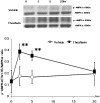A Single Oral Administration of Theaflavins Increases Energy Expenditure and the Expression of Metabolic Genes
- PMID: 26375960
- PMCID: PMC4574049
- DOI: 10.1371/journal.pone.0137809
A Single Oral Administration of Theaflavins Increases Energy Expenditure and the Expression of Metabolic Genes
Abstract
Theaflavins are polyphenols found in black tea, whose physiological activities are not well understood. This study on mice evaluated the influence of a single oral administration of theaflavins on energy metabolism by monitoring the initial metabolic changess in skeletal muscle and brown adipose tissue (BAT). Oxygen consumption (VO2) and energy expenditure (EE) were increased significantly in mice treated with theaflavin rich fraction (TF) compared with the group administered vehicle alone. There was no difference in locomotor activity. Fasting mice were euthanized under anesthesia before and 2 and 5, 20-hr after treatment with TF or vehicle. The mRNA levels of uncoupling protein-1 (UCP-1) and peroxisome proliferator-activated receptor gamma coactivator-1α (PGC-1α) in BAT were increased significantly 2-hr after administration ofTF. The levels of UCP-3 and PGC-1α in the gastrocnemius muscle were increased significantly 2 and 5-hr after administration of TF. The concentration of phosphorylated AMP-activated protein kinase (AMPK) 1α was also increased significantly in the gastrocnemius 2 and 5-hr after treatment with TF. These results indicate that TF significantly enhances systemic energy expenditure, as evidenced by an increase in expression of metabolic genes.
Conflict of interest statement
Figures




Similar articles
-
Enhancement of energy expenditure following a single oral dose of flavan-3-ols associated with an increase in catecholamine secretion.PLoS One. 2014 Nov 6;9(11):e112180. doi: 10.1371/journal.pone.0112180. eCollection 2014. PLoS One. 2014. PMID: 25375880 Free PMC article.
-
R-α lipoic acid γ-cyclodextrin complex increases energy expenditure: a 4-month feeding study in mice.Nutrition. 2014 Feb;30(2):228-33. doi: 10.1016/j.nut.2013.08.002. Nutrition. 2014. PMID: 24377457
-
A single oral dose of flavan-3-ols enhances energy expenditure by sympathetic nerve stimulation in mice.Free Radic Biol Med. 2016 Feb;91:256-63. doi: 10.1016/j.freeradbiomed.2015.12.030. Epub 2015 Dec 29. Free Radic Biol Med. 2016. PMID: 26738802
-
Differentiation and characterization in primary culture of white adipose tissue brown adipocyte-like cells.Int J Obes (Lond). 2009 Jun;33(6):680-6. doi: 10.1038/ijo.2009.46. Epub 2009 Mar 10. Int J Obes (Lond). 2009. PMID: 19274054
-
Effect of oral theaflavin administration on body weight, fat, and muscle in healthy subjects: a randomized pilot study.Biosci Biotechnol Biochem. 2017 Feb;81(2):311-315. doi: 10.1080/09168451.2016.1246170. Epub 2016 Oct 19. Biosci Biotechnol Biochem. 2017. PMID: 27756182 Clinical Trial.
Cited by
-
Antiviral effect of theaflavins against caliciviruses.J Antibiot (Tokyo). 2017 Apr;70(4):443-447. doi: 10.1038/ja.2016.128. Epub 2016 Oct 19. J Antibiot (Tokyo). 2017. PMID: 27756911
-
Theaflavins Improve Insulin Sensitivity through Regulating Mitochondrial Biosynthesis in Palmitic Acid-Induced HepG2 Cells.Molecules. 2018 Dec 19;23(12):3382. doi: 10.3390/molecules23123382. Molecules. 2018. PMID: 30572687 Free PMC article.
-
Nutraceuticals in Brown Adipose Tissue Activation.Cells. 2022 Dec 10;11(24):3996. doi: 10.3390/cells11243996. Cells. 2022. PMID: 36552762 Free PMC article. Review.
-
Polyphenol- and Caffeine-Rich Postfermented Pu-erh Tea Improves Diet-Induced Metabolic Syndrome by Remodeling Intestinal Homeostasis in Mice.Infect Immun. 2017 Dec 19;86(1):e00601-17. doi: 10.1128/IAI.00601-17. Print 2018 Jan. Infect Immun. 2017. PMID: 29061705 Free PMC article.
-
Identification and Characterization of Zika Virus NS5 Methyltransferase Inhibitors.Front Cell Infect Microbiol. 2021 Apr 7;11:665379. doi: 10.3389/fcimb.2021.665379. eCollection 2021. Front Cell Infect Microbiol. 2021. PMID: 33898335 Free PMC article.
References
-
- Haslam E. Thoughts on thearubigins. Phytochemistry. 2003;64(1):61–73. Epub 2003/08/30. . - PubMed
-
- Knaze V, Zamora-Ros R, Lujan-Barroso L, Romieu I, Scalbert A, Slimani N, et al. Intake estimation of total and individual flavan-3-ols, proanthocyanidins and theaflavins, their food sources and determinants in the European Prospective Investigation into Cancer and Nutrition (EPIC) study. The British journal of nutrition. 2012;108(6):1095–108. Epub 2011/12/22. 10.1017/s0007114511006386 . - DOI - PubMed
-
- Vogiatzoglou A, Mulligan AA, Luben RN, Lentjes MA, Heiss C, Kelm M, et al. Assessment of the dietary intake of total flavan-3-ols, monomeric flavan-3-ols, proanthocyanidins and theaflavins in the European Union. The British journal of nutrition. 2014;111(8):1463–73. Epub 2013/12/18. 10.1017/s0007114513003930 . - DOI - PubMed
Publication types
MeSH terms
Substances
LinkOut - more resources
Full Text Sources
Other Literature Sources
Research Materials
Miscellaneous

